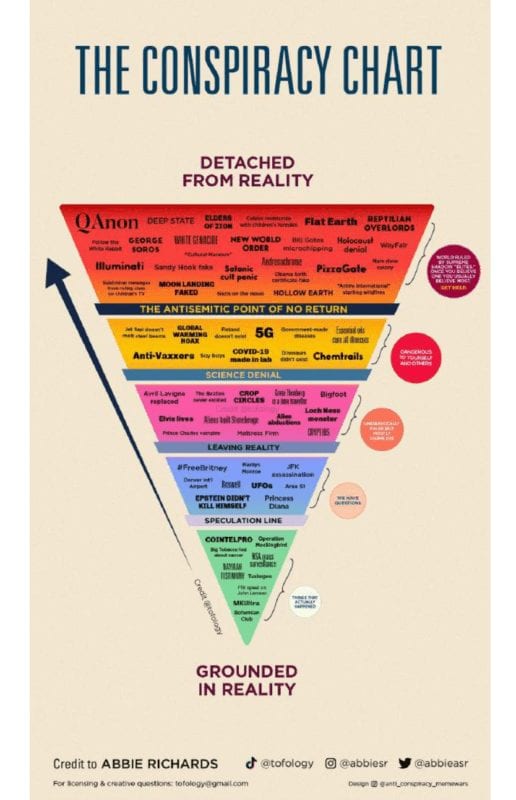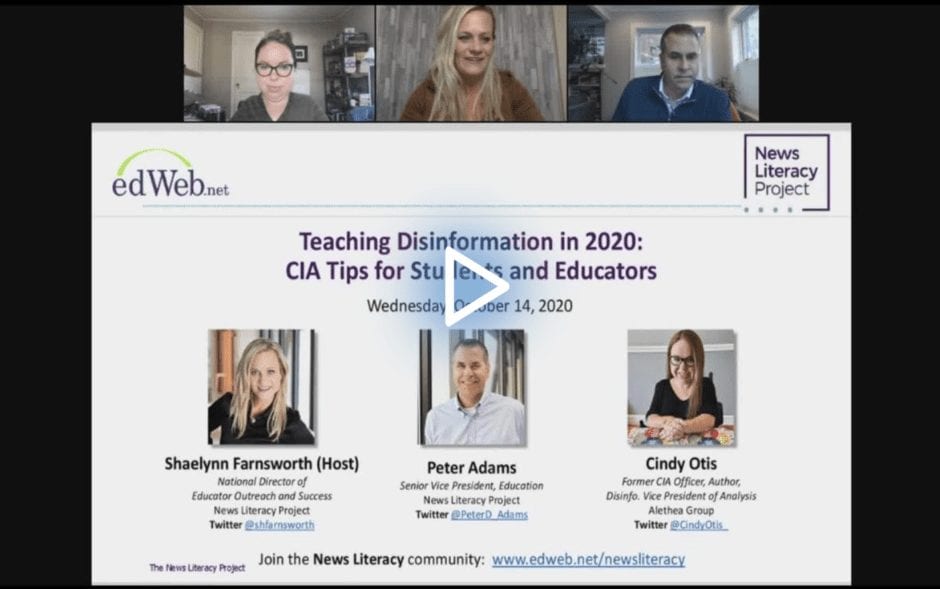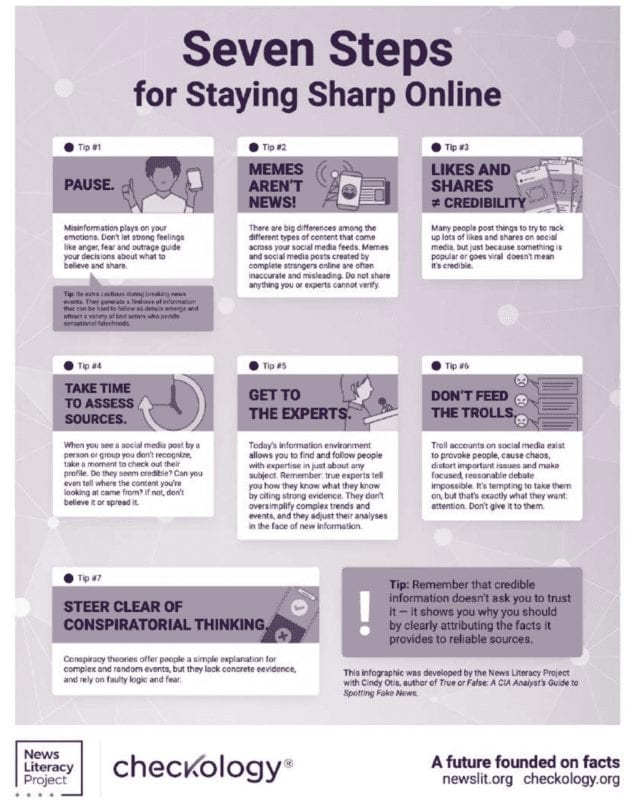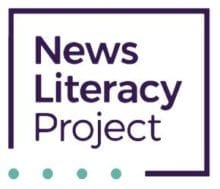Separating Fact from Fiction: Why News Literacy Education is Essential
By Ginny Kirkland
Today’s students are inundated with information from myriad media sources—social media, blogs, podcasts, text messages, television, internet searches, radio, email, and other communication apps. The list seems almost endless, and it most certainly is overwhelming.
Understanding how to separate fact from fiction in media was recently discussed in the edWebinar, Teaching Disinformation in 2020: CIA Tips for Students and Educators, sponsored by the News Literacy Project. The panelists were news literacy experts Cindy Otis, Vice President of Analysis for Alethea Group and former CIA Officer, and Peter Adams, Senior Vice President of Education for the News Literacy Project.
With the 2020 election season well underway, many Americans have not only been bombarded with campaign communications intended to sway voters, but also fake news stories and disinformation “campaigns” intended to create confusion and even fear. To exacerbate matters, due to the current COVID-19 crisis, many students are spending more time than ever in front of a screen making them more susceptible to consuming false and misleading information.
News Literacy Education: 21st Century Skill
With the amount of information circulating in the world today, Adams argues that news literacy education is not a “nice-to-have” skill, it is a “must-have” skill for the 21st century. Adams provides three core reasons for news literacy education:
- Information drives civic engagement and empowerment making it the basis for students’ civic literacy and their agency.
- Today’s students are inheriting the largest and most complex information landscape in human history.
- Failing to prepare students to successfully navigate and play a role in shaping the information environment is disempowering and unfair.
While teachers agree about the necessity of developing this all-important skill in their students, the challenge is how to help their students become proficient news sleuths who understand how to identify legitimate sources and disregard untrustworthy information.
Disinformation, Misinformation and Fake News
Otis likens our collective experience with the news to that of casting out a net to gather information but instead receiving garbage that has to be waded through, sifted, and identified. Once identified, why does it really matter if it’s fake news, disinformation, or misinformation? According to Otis, there is a difference and it has to do with intent. Disinformation campaigns are created with the explicit intent to mislead an audience with incorrect information to produce a desired outcome. Misinformation happens when a piece of information turns out to be false but was shared because the person or news organization thought it was correct. While still damaging, the ability to correct the mistake is possible and can rectify some of the damage. The term “fakes news,” most recently, has been used to target certain media organizations as producers of false or fake stories. Regardless of the distinctions between these terms, they all underscore the need for legitimate journalism that adheres to a process and methodologies that result in straight news reporting.
The Taxonomy of Misinformation
Claire Wardle from First Draft News created this taxonomy of misinformation to highlight how information can be warped, taken out of context, or falsely created to promote or drive conspiracy theories. Even satire can often be mistaken for legitimate news and have an unintended impact.

What is News Literacy Education?
After sharing examples of how quickly misinformation and disinformation can make their way around the world through social media, blogs, and legitimate news sites, Adams and Otis explained how news literacy education helps students learn what’s credible, what’s not, and the role that quality journalism and a free press play in a democracy. It also teaches students how to engage with news outlets and respond to coverage they think is lacking or problematic.
News literacy education is comprised of five core standards: Verification, Sourcing, Fairness, Accountability and Transparency, and Context. Using these standards, students develop a better understanding of the important difference between user-generated content (anyone can create a meme) to standards-based content (a correctly researched and sourced article).
In addition to teaching the five core standards, students also learn about propaganda and how it differs from disinformation and misinformation. Otis shared that propaganda is often government sponsored with the goal of shifting public opinion about government policies, actions, or outcomes.
Trolls, Bots, and Sockpuppets
They may sound like characters from a children’s storybook, but trolls, bots, and sockpuppets are popular tools used by bad actors to influence how people interact with online news stories. Trolls use provocative or inflammatory language to engage people in message boards and comment sections to try to goad them into arguments. Sockpuppets are fake accounts created by a person who is masquerading as another person to try to spread disinformation, and bots are automated responses intended to make someone think they are interacting with a real person. News literacy education teaches students how to identify each of these nefarious tools to avoid interacting with them.
Staying Sharp Online
While it might be tempting for students to be so overwhelmed that they distrust all news, Adams says the key to avoiding becoming a cynic is to “remember that credible information doesn’t ask you to trust it—it shows you why you should by clearly attributing the facts it provides to reliable sources.” Adams and Otis closed the presentation by sharing Seven Tips for Staying Sharp Online:
- Pause: Ask yourself, is this information trying to be provocative or emotive?
- Memes Aren’t News: Anyone can create a meme
- Likes and Shares Do Not Equal Credibility: Just because someone likes it, doesn’t make it true
- Take Time to Assess Resources: What is the source of the information?
- Get to the Experts: Who is validating the information, what is their expertise?
- Don’t Feed the Trolls: They are a waste of time
- Steer Clear of Conspiratorial Thinking: Mistaking coincidences for actual evidence
Educators are invited to visit the News Literacy Project where they can find a vast array of free resources and programs to support news literacy education.
This edWeb broadcast was sponsored by the News Literacy Project.
About the Presenters
Peter Adams is the News Literacy Project’s Senior Vice President of Education. He began his career as a classroom teacher in New York City schools through Teach For America. He has also taught in the Chicago public schools, at Roosevelt University, and at Chicago City Colleges’ Wilbur Wright campus. In addition, he has worked with the NYC Teaching Fellows program, with After School Matters, and as an independent education consultant.
Since joining NLP in 2009, he has coordinated classroom and after-school programs, served as Chicago program manager, worked on organizational strategy, and developed NLP’s digital program. He has also provided news literacy training and workshops to educators and others throughout the area. He was promoted to his current position in January 2014 and oversees NLP’s education team, which develops resources and training for teachers. He and the other team members are based in Chicago.
Peter is a graduate of Indiana University, where he majored in English and African American studies and co-founded an independent monthly student newspaper. He has a master’s degree in the humanities from the University of Chicago.
Cindy L. Otis is the Vice President of Analysis for Alethea Group, a disinformation investigation, and remediation firm, and is an expert on disinformation threat analysis and counter-messaging. She is also a Senior Non-Resident Fellow at the Atlantic Council’s Digital Forensic Research Lab and an Associate at Argonne National Lab. Prior to joining the private sector in 2017, she served in the CIA as a military analyst, intelligence briefer, and a manager in the Directorate of Intelligence. While at the CIA, she specialized in security issues in Europe, the Middle East, and North Africa. She is a frequent media commentator and is regularly cited in publications such as The Washington Post, New York Times, Politico, and NPR; she is a member of USA Today’s Board of Contributors. Cindy is also the author of the newly released, True or False: A CIA Analyst’s Guide to Identifying and Fighting Fake News, out now with Macmillan.
About the Host
Shaelynn Farnsworth is News Literacy Project’s national director of educator outreach and success. Shaelynn has over 20 years of experience in education. She spent the first part of her career as a high school English teacher in Conrad, Iowa, where she reimagined teaching and learning in her classroom and became a leader in the convergence between literacy and technology. Shaelynn focused on developing student skills in information consumption, creating innovative ways for students to demonstrate understanding, and inspiring healthy skepticism in the digital age. She was recruited by a regional state education agency in Iowa, where she was a school improvement consultant for seven years. Shaelynn supported districts throughout Iowa in the areas of literacy, technology, AIW, and systemic change. She was a member of the state’s literacy, social studies, and technology leadership teams. Shaelynn holds a bachelor’s and a master’s degree in English from the University of Northern Iowa.
Join the Community
News Literacy is a free professional learning community on edWeb.net where educators work together to develop their students’ civic knowledge and critical thinking skills when consuming news and information.
The News Literacy Project is a nonpartisan national education nonprofit, provides programs and resources for educators and the public to teach, learn and share the abilities needed to be smart, active consumers of news and information and equal and engaged participants in a democracy.
Ginny Kirkland is president of GK Works, Inc., a marketing, research, communications and government relations consultancy business that specializes in the K-12 education market. With more than 20 years of experience in the K-12 sector, Ginny works with for-profit and non-profit entities to create strategic marketing campaigns to reach high-level policy and decision makers while also finding creative ways to reach grassroots practitioners like school administrators, classroom teachers, K-12 support staff and the organizations and associations who represent them. She also works with edWeb.net to write articles on their professional learning edWebinars.






Comments are closed.